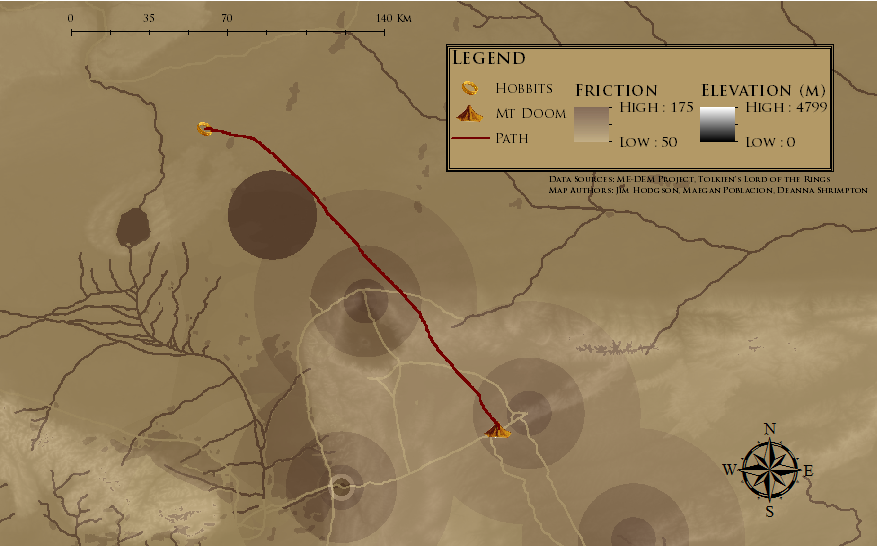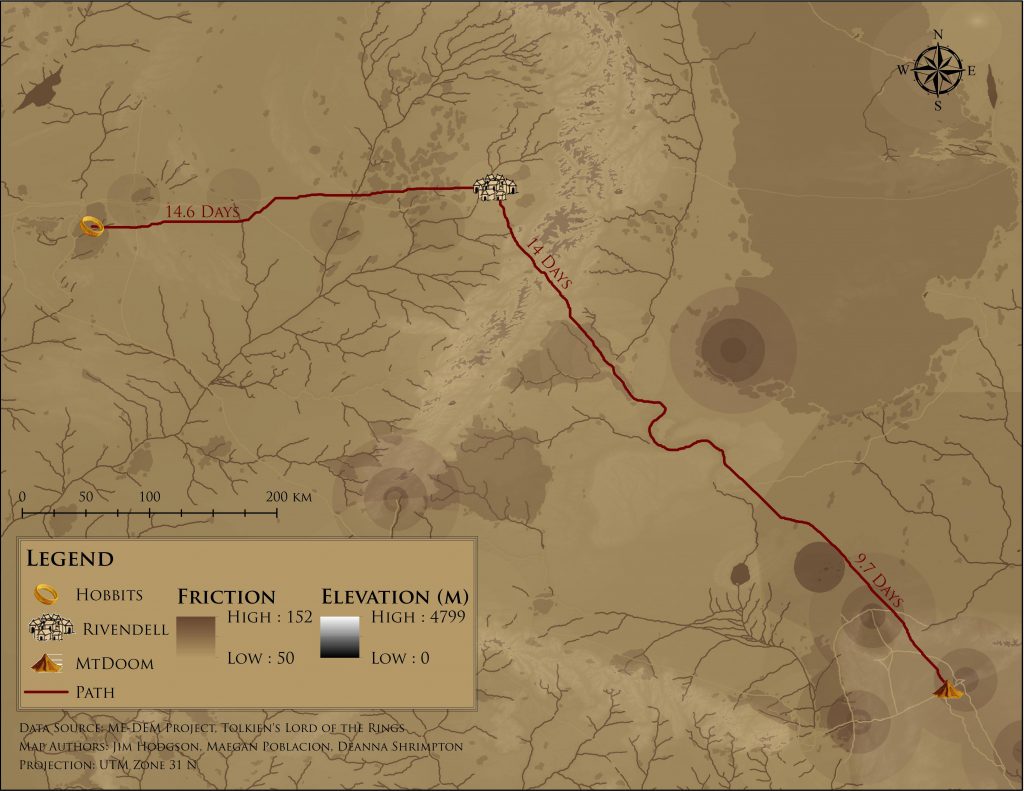3.1 The Shire to Rivendell

Figure 3.1 Best path from the Shire to Rivendell, September 26 – October 11.
We found that when we compare only travel time and ignore time spent resting, the best path still takes only half as long as the actual route taken by Frodo. In the story, Frodo & co. take approximately a month to get from the Shire to Rivendell, with a few days of rest in between.
3.2 Rivendell to the Dead Marshes

Figure 3.2 Best path from Rivendell to the Dead Marshes, October 11 – October 25.
What is most interesting about this step is that it fairly closely mirrors the actual path taken in the story, after they’ve crossed the mountains. They follow the river until it is no longer beneficial to do so, and then they break and cut across the Dead Marshes. At this point in the story they have Gollum as their guide, and are able to cross the marshes fairly safely. This represented in our model as marshes being hostile territory, but with a guide they are just as difficult to traverse as grasslands.
It is also worth noting that the hobbits’ average speed over this stretch is 1% faster than their base walking speed. This is because much of their time spent traveling is in boats down the river, which is much faster than walking. However, also in this stretch is their mountain crossing, which brings the average speed back down again. On average they travel at roughly 101% of their base walking speed, as seen in section 3.5, below.
3.2 The Dead Marshes to Mount Doom

Figure 3.3 Best path from the Dead Marshes to Mount Doom, October 25 – November 4.
Finally, they make it to mount doom. Notice the change in trajectory between the ending point of figure 3.2 and the beginning of figure 3.3, and the changes in friction values. This is a product of our shifting landscape model, in which the Nazgul’s positions are updated every two weeks. Between maps 3.2 and 3.3, a Nazgul appeared in their path. Because of the extremely high friction cost of Nazguls, the path in map 3.3 re-routes to go around it, preferring instead to cross the mountains into Mordor than to go through the Black Gate. A wise decision.
3.4 Total Journey

Figure 3.4 The cumulative path taken from the Shire to Mount Doom and the amount of time taken for each time step. September 26 – November 4.

Figure 3.5 The original route taken in the story, created by Mark Crosby and posted to Reddit (here).
This shows the final full path that they take. When compared to the journey taken in the original story (figure 3.5), we see much less doubling-back and wide detours. The best path that we model takes a much more direct route, even if it becomes difficult at times. The biggest differences are how our route deals with mountains. It seems as if in the story path mountains are a much more significant barrier to travel than they are for our path, as shown by where and how they cross the Misty Mountains, and later into Mordor.
3.5 Data and Numbers
| Average Friction Cost |
Average Speed Modifier |
Average Speed (km/h) |
Distance (km) | Time (days) | |
| Sept 26 – Oct 11 | 120.63 | 79% | 2.82 | 329.75 | 14.6 |
| Oct 11 – Oct 25 | 98.43 | 102% | 3.61 | 404.64 | 14 |
| Oct 25 – Nov 4 | 128.03 | 72% | 2.56 | 198.65 | 9.7 |
From mapping the least cost path in stages of 2 weeks of travel at a time, it was found that the total travel time is 38.3 days.
In the books, Frodo’s travel time to Mount Doom took 3 months (6 months if we include resting time spent at Rivendell while injured). Our analysis found that Frodo could have taken a far more efficient route to Mt. Doom. Overall, the least cost path was 2.5 times faster than the literary route, saving the Fellowship a over a month and a half of travel time.